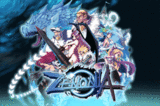Zenonia, despite a long list of technical flaws, is still worth playing.
Now that it's been ported on the DS, it's even better, with the use of physical controls instead of virtual ones. Not only that. but the bottom screen is used as the map screen, unlike in the iPhone version, where the map was shoved unceremoniously into the top-left corner of the screen. They're Two small improvements, but they go a long way to making the game less cluttered.
As for the plot, you are Regret, a young man who tries to solve the mystery of his father's death. Like a traditional RPG, you'll roam around the game world, talk to people, buy equipment, defeat monsters, and gain experience points. The leveling up system works well; every time you gain a level, you'll earn three skill points that you can add to any of four categories: CON, which raises your health, STR, which raises your attack power and how much you can carry before becoming over-encumbered. SPI, which raises your magic points and how fast they recharge, and finally, AGI, which increases your chance of accuracy, evade, and critical attack. In addition to that, you get 1 skill point, which you can invest into an active skill (mostly attack powers) or a passive skill (such as 2% critical damage increase). With these varying skill options, it's likely that you and somebody else will not play the game in the same way.
There are three classes; Warrior, Paladin, and Assassin. Paladin is magic focused, Warrior is combat-focused, and Assassin is speed focused. Unfortunately, since the only button you can use to attack is A, combat boils down to mashing the attack button, so there's hardly any difference between playing between classes. In fact, I'd say Assassin is flat-out better than the other two, since he has a naturally faster run speed. Other than the A button, you can also assign an active skill to one of four available quick slots. This provides an alternate method of attack, but most of the time, these abilities are unreliable. For example, even after upgrading the Warrior ability 'Crash' up to level 10, it would sometimes take out 25% of an enemy's life bar, while other times it wouldn't even have any visual impact at all.
Performing these moves drains your stamina, which is measured by a yellow bar below your health bar. This bar is also an indication of your 'Hunger' level. When your hunger goes down, your maximum SP will go down as well, along with the recharge speed. The only way to get back up to the maximum limit is to eat something, thus restoring your hunger. This means that you're constantly having to waste your gold in order to buy food to restore your hunger meter. A feature like this doesn't add any depth to the game, but rather, it's just feels like something that was tacked on.
The graphics are bright, cartoony, and very colourful. It's reminiscent of a game you would see on the Super Nintendo back in the 90's. The towns are nicely detailed, and there are many different sprites for the people that inhabit them, which makes the game feel more alive. You can also talk to these people for side-quests. Folks that are in need of your assistance are labelled on the map screen with a bright question mark, so you don't have to chat everyone up hoping for a side mission. Unfortunately, these small assignments are very bland, and usually fall into the category of either 'Kill "X" number of enemies' or 'Bring this object from point A to point B'.
However, you're going to need to do some of these quests for the experience rewards, simply because of the amount of grinding you'll need to do if you want to keep up with the enemies levels. By the time you're about 5 hours into the game, the enemies will most likely be 6-8 levels higher than you. At one point in the game, I had to spend 40 minutes killing the same enemies over and over just to be able to move to the next screen without getting my ass kicked.
But, of course, there's one flaw that the developers overlooked that actually makes the need to level up obsolete.
Each time you die (And trust me, you will die), you will be given two options: Pay 3000 coins and be instantly revived, or 'Penalty Continue', in which your item durability will decrease, as well as the rate that you gain experience. But, even if you don't have enough gold to select the Instant Continue, you can still choose it regardless, you'll just lose whatever gold you had on you at that time. But, if you can just keep continuing infinitely with no penalty whatsoever,
there's not much point to collecting gold, is there?
One thing that any player will appreciate in Zenonia is the ridiculous dialogue that some of the NPC's will spew out, such as "I did a few bad things back in the days... But I'm clean now after taking a shower." or "Go away! I'm just an NPC! We can't be together!", or my personal favourite, "Too much YouTube can ruin your life."
In conclusion, Zenonia is riddled with flaws, but at the same time, it has an inexplicable charm that kept me playing until the end. Maybe it's the laughably translated English, or maybe it's the vivid and colourful world. It has the potential to be a great RPG, but the problems can be tough to look past.

